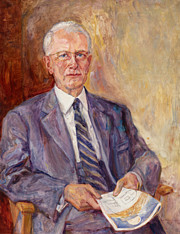Prof. Otto Heckmann
ESO Director General from 1962 until 1969
 Otto Heckmann was born on 23 June 1901 in Opladen, Germany. Heckmann received a PhD in astronomy from the University of Bonn in 1925, following an early interest in the subject. After graduating, he stayed at the university as an assistant astronomer in its observatory between 1925 and 1927. He then moved to the University Observatory in Göttingen where he became the assistant of Hans Kienle, then director of the observatory between 1927 and 1935. In 1929 Heckmann also became a lecturer of astronomy at the University of Göttingen, eventually becoming an assistant professor in 1935.
Otto Heckmann was born on 23 June 1901 in Opladen, Germany. Heckmann received a PhD in astronomy from the University of Bonn in 1925, following an early interest in the subject. After graduating, he stayed at the university as an assistant astronomer in its observatory between 1925 and 1927. He then moved to the University Observatory in Göttingen where he became the assistant of Hans Kienle, then director of the observatory between 1927 and 1935. In 1929 Heckmann also became a lecturer of astronomy at the University of Göttingen, eventually becoming an assistant professor in 1935.
Heckmann was noted for his work in many areas of research including cosmology, astrometry and photometry of stars, and instrumentation. In 1931, he proved that, under the assumptions that matter is uniformly distributed with identical properties throughout the Universe, the General Theory of Relativity could result in either an open or closed Universe. He later proposed the idea of a rotating universe. Fascinated by Edwin Hubble’s 1929 discovery of the redshift-distance relation of extragalactic nebulae, Heckmann published the book Theorien der Kosmologie (Theories of Cosmology) in 1942, which categorised cosmological theories from the emerging field of study.
In 1941, Heckmann became the director of the Hamburg Observatory and Head of the Department of Astronomy at Hamburg University. While in this position Heckmann helped finish the star catalog Astronomische Gesellschaft Katalog (Astronomical Society Catalog) 2, known as AGK2. He then led the multi-national effort to photograph and chart 180,000 stars in the Northern Hemisphere for AGK3, the follow-up to AGK2.
Heckmann was also interested in developing instrumentation for observatories. Inspired by fellow German astronomer Walter Baade, who once built a large Schmidt telescope, Heckmann partly led the design and construction of the Hamburg Big Schmidt at Hamburg University. This experience later proved useful for Heckmann during the initial stages of the European Southern Observatory (ESO).
Following a lecture at the Leiden Observatory in The Netherlands by Baade in 1953, where he called for a southern observatory for European researchers, a group of outstanding European astronomers, among them Heckmann, decided to realize this project. Heckmann greatly contributed to planning this observatory in subsequent years, creating hope and trust so that the observatory could become a reality. In 1962 he became the first Director General of the newly created ESO. During his seven-year term, Heckmann brought the ESO Headquarters and the first ESO observatory, La Silla Observatory, into operation and developed the fundamental structure of the organisation.
In addition to his tenure as Director General of ESO, Heckmann also served as President of the International Astronomical Union from 1967 to 1970.
Among his many honours he received doctoral degrees from universities in France, Argentina, and the United Kingdom, the James Craig Watson Medal of the U.S. National Academy of Sciences in 1961, the Jules Janssen Prize from the French Academy of Science in 1962 and the Bruce Medal of the Astronomical Society of the Pacific in 1964.
Otto Heckmann died in Göttingen, Germany, on 13 May 1983.
A detailed CV is below.
Prof. Otto Hermann Leopold Heckmann
Born in Opladen, Nordrhein-Westfalen, Germany in 1901; German nationality
Died in Göttingen, Germany, on 13 May 1983
Education:
PhD in Astronomy, University of Bonn (1925)
Opladen Gymnasium, Opladen, Germany
Professional Activities:
- 1925–1927: Assistant Astronomer, Observatory of the University of Bonn, Germany
- 1927–1935: Assistant Astronomer, Observatory of the University of Göttingen, Germany
- 1929–1935: Lecturer in astronomy at the University of Göttingen, Germany
- 1935–1941: Assistant Professor, University of Göttingen, Germany
- 1941–1962: Director of the Hamburg Observatory and Head of the Department of Astronomy at Hamburg University, Germany
- 1952–1957: President of Astronomische Gesellschaft (Astronomical Society)
- 1962–1969: Director General of ESO
- 1967–1970: President of the International Astronomical Union
Research: Astrometry, Photometry, Cosmology, Relativity and Statistical Mechanics.
Publications: authored and co-authored over 15 refereed papers and books.
Memberships:
- Chairman of the Gesellschaft Deutscher Naturforscher und Ärzte, 1954–1956
- Elected member of the Academy of Sciences Leopoldina, 1956
- Associate of the Royal Astronomical Society
- Elected or foreign member of 11 academies of Science
Other Affiliations and Honours:
- James Craig Watson Medal, U.S. National Academy of Sciences, 1961
- Jules Janssen Prize, French Academy of Science, 1962
- Bruce Medal, Astronomical Society of the Pacific, 1964
- DrHC, University of Marseille, 1966
- DrHC, University of La Plata, 1968
- DrHC, University of Sussex, 1970
- Asteroid designated 1650 Heckmann, International Astronomical Union, 1977